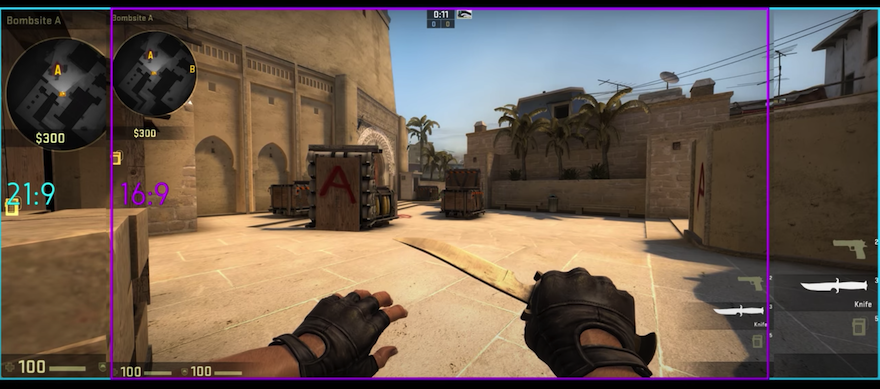You can get a cheap monitor starting at less than Rs. 5000 or $75 but there are also a few monitors that cost more than Rs. 150,000 or $2,000. Most gamers buy costly monitors offering high refresh rates. A good screen is really important for good gaming, so you shouldn’t compromise with it if you are looking to buy one for gaming. The important things you need to check while buying a gaming monitor are response time and refresh rate. Screen size, panel type, and resolution are also important. In this guide, I will explain what to look for while buying a good gaming monitor. After reading this guide, you will understand everything about monitors for making buying decisions.
Monitor size and resolution
Most people are satisfied with 24-inch screens. This size is big enough for good gaming. There are many gamers who go with a bigger 27-inch screen. It depends on your choice.
The 24 inches 1080p display is the most common and it works fine with most setups. People who invest big go with 27 inch 1440p screen but it requires mid-to-high-end hardware. Pro gamers who invest bug amount buy an even bigger screen with 4K resolution. You need high-end specs to make the most use of it.
Optimal monitor size/resolution combinations.
- 24″ or smaller: 1920×1080
- 27″-32″: 2560×1440 and 3840×2160
- 32″ or bigger: 3840×2160
- 25″-23″ ultrawide: 2560×1080
- 34″-35″ ultrawide: 3440×1440
- 38″ ultrawide: 3840×1600
- 43″ super-ultrawide: 3840×1200
- 49″ super-ultrawide: 5120×1440
Always make sure that you have a CPU/GPU that can handle the monitor’s resolution at its maximum refresh rate.
Aspect ratio
The aspect ratio is another minor factor you need to consider. You can go with the Wide(16:9) or Ultrawide (21:9) screen depending on your choice. It also depends on the games you will be playing. In certain games, the wide view can give you an advantage because you can see more of the game scene. See the below photo to understand it.
The 16:9 aspect ratio is fine for most of the games because support for 21:9 is limited. So, you won’t be able to utilize a wider view in most of the games. There are several gamers who still play at a 4.3 aspect ratio regardless of the monitor they have.
Response time
Response time is the time it takes for a pixel on the monitor to change from one color to another. It is measured in milliseconds (ms). Response time is directly related to the refresh rate.
| Range | 5 milliseconds or below |
| Scale | Lower is better |
| Sweet spot | 1 ms |
Refresh rate
The refresh rate is the rate at which the monitor changes images. The faster the refresh rate of the monitor, the smoother the image will be. The number of image changes per second is measured in hertz (Hz).
| Range | 75 Hz or above |
| Scale | Higher is better |
| Sweet spot | 144 Hz |
Cheap monitors come with a 60Hz refresh rate while there are gaming monitors with a whopping 360Hz refresh rate. Gaming monitors are available with several refresh rates such as 75Hz, 120Hz, 144Hz, 240Hz, and 360Hz. 360Hz gaming monitors are still not available in India but Asus showcased the ROG Swift monitor with a 360Hz refresh rate at CES 2020.
Also see: 240Hz Monitors
The difference between 240Hz and 144Hz is not as noticeable as it’s between 60Hz and 144Hz. 144Hz was the standard refresh rate for gaming monitors for over a decade but now gamers are moving to 240Hz panels. The faster refresh rate is really important for gaming, especially in first-person shooting games. It allows the screen to remain responsive to rapid movements. Counter-Strike: Global Offensive or Overwatch runs at hundreds of frames per second and can take advantage of high refresh rate monitors.
Watch this video to see how different refresh rates affect motion in a game.
The higher refresh rate will result in smoother gameplay as long as your FPS rate can keep pace with it.
Panel Type
There are different panel technologies including TN, VA, IPS, and OLED. All these have their advantages and disadvantages. OLED is costly and not many models are available.
TN (Twisted Nematic) panels don’t offer good color reproduction and viewing angles are also not good, but this panel offers a high refresh rate. If you want a monitor with a 1ms response time, you will get a TN panel. Playing competitive games on these monitors should give you the edge.
VA (Vertical Alignment) panels offer the best contrast ratio but they don’t offer a good response time performance.
IPS (In-Plane Switching) panels are the best to go with. These panels offer accurate and consistent colors, balanced picture quality, and the best viewing angles with good response time performance. IPS panels are mostly used in monitors for professionals in graphics design. These are also quite expensive.
Due to the lowest response time of 1 ms, most gamers go with TN monitors.
Adaptive Sync
While checking different gaming monitors, you will also see FreeSync or G-SYNC mentioned in the specs. If you don’t want to see screen tearing while playing games, you should consider monitors with Adaptive Sync.
In order to use these features, you need compatible GPUs. Some FreeSync monitors are also G-SYNC compatible. You need to do a bit of research for knowing all these things.
G-SYNC monitors have an integrated module to ensure a wide dynamic refresh rate range. But this tech also significantly increases the monitor cost. G-SYNC only works over G-SYNC On the other hand, FreeSync doesn’t increase the monitor’s price because it is based on the royalty-free standard. FreeSync also works over both HDMI and DisplayPort depending on the monitor.
Ports
You should also check available ports in the monitor. It should feature HDMI, DisplayPort, USB, and Audio jack. HDMI is the most common port but prefer DisplayPort. DisplayPort supports higher refresh rates and resolutions than HDMI. Some of the monitors also feature Ethernet port and USB-C ports. USB-C can support video, audio, and data transfer, making it a versatile port for gaming. Ethernet is actually common, but some gaming monitors come with an Ethernet port for a wired internet connection.
Additional features:
Some gaming monitors come with additional features such as built-in speakers, USB hubs, adjustable stands, and even RGB lighting. While these features aren’t strictly necessary, they can enhance your overall gaming experience.
What features are most important?
If you want smooth gameplay, refresh rate, response time, and Sync or FreeSync should be your priority. A high refresh rate and high response time give you an edge in competitive FPS games. If you want prettiness above smoothness, go with a monitor with an IPS panel, HDR, and 4K resolution. But make sure you have good hardware to support high resolution and HDR.
Wrap Up
Now you know about important things to look for in a gaming monitor. So, check all these things while buying a gaming monitor. If you are looking for a gaming monitor, you should go with a high refresh rate and low response time. Check all the options in the budget you have. Never settle for less than 144Hz refresh rate and sub 4ms response time for an uncompromised gaming experience.
We have also prep eased several lists of best gaming monitors of the different price segments. These lists offer the best products and save your time. We highly recommend you check out our gaming monitors list and select one for you.






